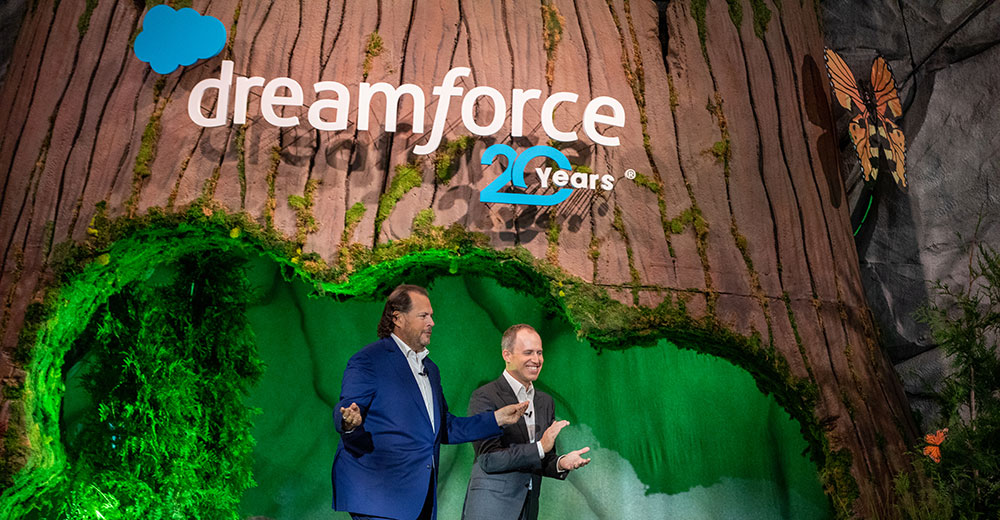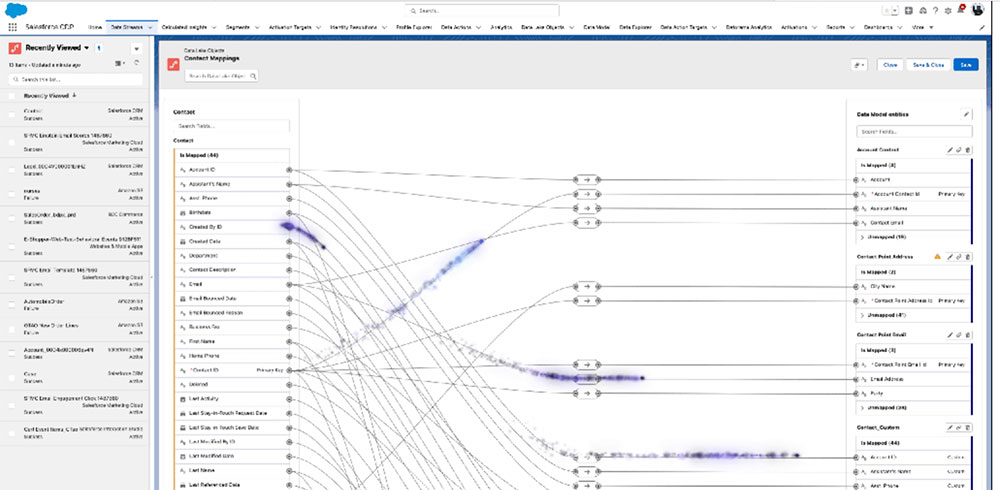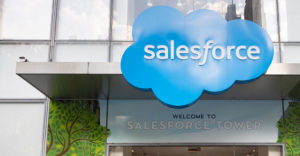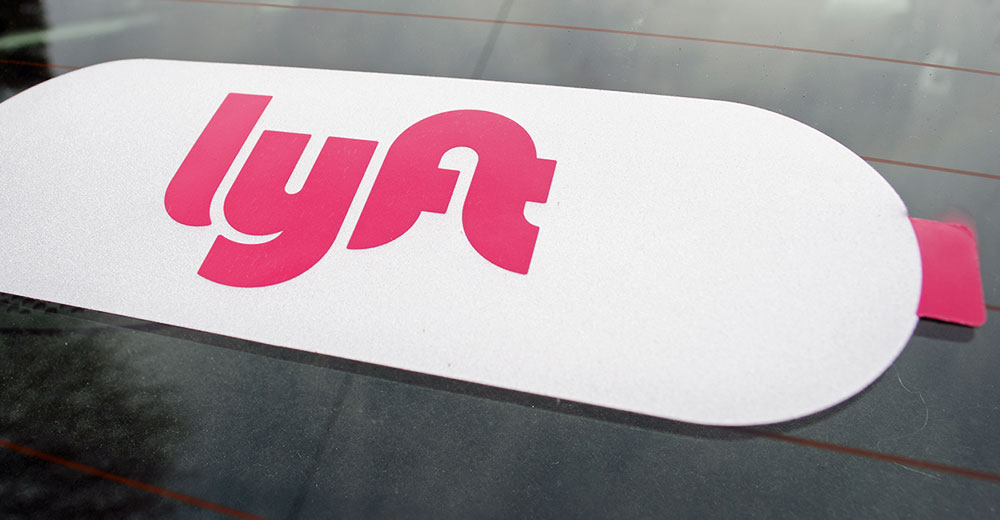Salesforce is reinventing itself. Again.
From the time of its inception, the company has marched to its own drummer, often alone, only to be pursued by so-called fast followers. The thinking was that fast following was almost as good as being the leader, but the slides at Dreamforce told a different story.
In Marc Benioff’s keynote slides, the fast followers were all bunched at about 5% of the market, while Salesforce sailed above at close to 30%. Yes, there’s still room at the top of the CRM industry, but who do you think has the better chance of capturing it? At some point, like when the fast followers bunch up, you have to admit that they’re more permanent laggards than followers threatening to catch up.
To drive that point home, Benioff mentioned in passing that his company’s revenues in the latest quarter pulled ahead of SAP’s — making Salesforce, by one measure at least, the bigger of the biggest enterprise software companies.
But back to reinvention.
It’s been a long time arriving, but Salesforce is changing by doing its best to change the economy, and the ground rules business has been operating under since Milton Friedman’s heyday.
Friedman was the anti-Keynesian championing the idea of shareholder supremacy in the mid-twentieth century. Where Friedman saw shareholders, the Keynesians (John Maynard Keynes had already passed from the scene) saw stakeholders. They included employees, local communities, suppliers, and, importantly, customers.
There has been a seesaw battle between the camps for several decades. Friedman won a Nobel Economics Prize, while Keynes died long before the prize was innovated. Paul Samuelson, one of many Keynesians, won a Nobel just prior to Friedman. Lately, the Business Round Table, an association of major corporation CEOs, has thrown its weight behind the stakeholder school.
CRM has become one of the tools of stakeholder business with its emphasis on, well, the customer and, lately, Salesforce’s embrace of other stakeholders. Salesforce’s core values include developing trust all around and embracing enlightened attitudes about sustainability exemplify this arrangement.
Salesforce Genie, Real-Time CRM
The company’s latest innovation, and a reason it remains the vendor to follow, is real-time CRM, represented by a new element of its service called Genie.
Salesforce Genie takes billions of data points about customers in real time, from any system or interaction and harmonizes it into one, dynamic single “source of truth” that changes as a customer does. (Image Credit: Salesforce)
Genie delivers, almost like pixie dust, the information needed to keep deals moving forward in real time whether that information is used by people or by bots mediating online purchases.
It’s a slick trick in the best sense of the words. Genie has to manage and manipulate and crunch Salesforce and third-party data to deliver useful information where and when it’s needed. It’s a further articulation of the Customer 360 effort, perhaps on the tech equivalent of steroids, and it is very powerful.
But I have trepidations about some of this because I’ve been around CRM long enough to have seen many of what seemed like unalloyed goods develop barnacles.
For example, social media was once seen as a great unifier, though it’s hard to feel that today. Or look at the Net Promoter Score. It was once a powerful tool for understanding customer reactions to business, but today too many businesses forewarn customers that a survey is on the way and only a rating of nine or 10 is useful — making the NPS useless as a forecasting tool and not much more than apple polishing.
I wonder how long it will take businesses to find workarounds to Genie that sideline difficult customer issues. As we saw with the NPS and social media, it’s not the tools but how you use them that makes all the difference.
Net Zero Cloud, Sustainability Management
Speaking of how you use a tool, Salesforce stepped up in a big way to make sustainability issues core to its values. That’s to be applauded, but much work remains. Salesforce’s Net Zero Cloud initiative has a few holes in it, though admittedly, it’s better to have a few holes in the sail than no sail at all.
What’s good about Net Zero is that it takes a balanced approach to the twin issues of climate change — pollution and emissions. Although we may equate the two, they are different. On the pollution front, the company has embraced the Trillion Tree initiative, and on the emissions front, it has some credible technology for counting and then curbing emissions.
But here’s the rub. Too often, we equate carbon capture with carbon sequestration. While trees can certainly capture carbon, they only live about a century on average and then they release their carbon back into the environment. So that’s a B+ on capture but a D on sequestration.
Carbon Tracking
The carbon we burn today has been underground for upwards of hundreds of millions of years, and it would stay put if not for our industrious efforts. That’s sequestration so we need to keep working on that front.
Emissions are rapidly moving to the rearview mirror. States are announcing curtailment of internal combustion engines for transport by 2035, as California did this summer. Salesforce’s emissions tracking and calculating tools are a good effort at documenting carbon use, but other events of this summer say they may not find a home.
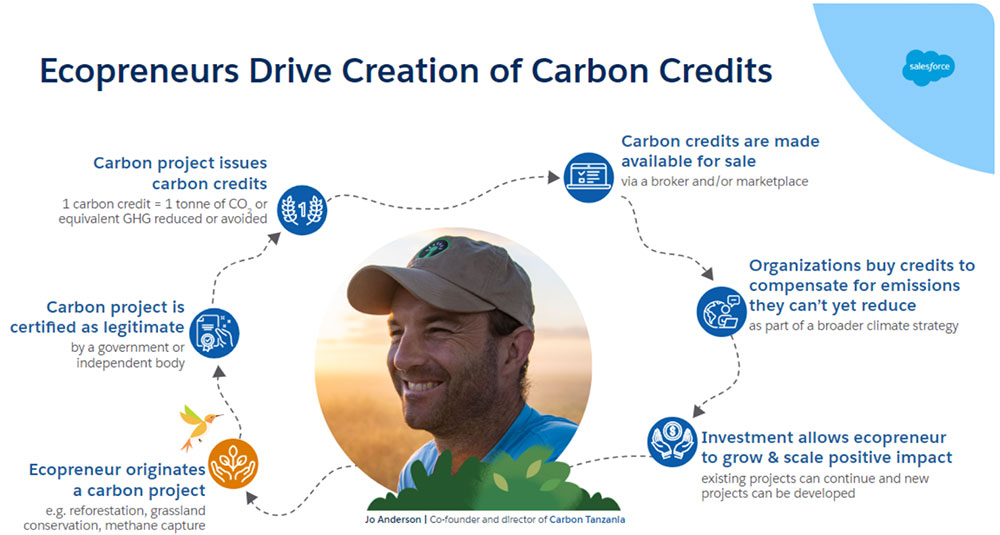
Net Zero Marketplace will be available for carbon credit purchases in the U.S. starting in October 2022 and will be expanding to additional markets in 2023. (Image Credit: Salesforce)
Carbon tracking is useful if you intend to implement a carbon tax, as many EU countries do. But the events of this summer and the 20 or so summers before suggest we’ll not see such a regimen in tax-phobic countries like the U.S.
This summer’s Inflation Reduction Act sustainability legislation drove a nail into the coffin of a carbon tax and substituted a profit motive for switching to renewables. So far, profits seem to have the upper hand. Milton Friedman would approve.
Curtailing the internal combustion engine is fine as far as the environment is concerned, but it suggests that Salesforce’s Net Zero has some retooling to do. One thing that businesses and environmentalists alike have avoided like Ebola is putting a stake in the ground that determines how much carbon is in the environment and how much must be removed. That’s not trivial, given the wildfires and droughts experienced across the Northern Hemisphere this summer.
We’re not yet at the point of raising global temperatures to the freakout point of 1.5 degrees Celsius above pre-industrial levels that the IPCC has warned about. But given what’s already happening, do we need to wait? Do we really think there’s headspace?
My Take
By my estimate, there are between one and two trillion tons of excess carbon in the environment that needs to be removed and sequestered to return us to a more acceptable late-twentieth-century climate. With that reality, Net Zero might need to be replaced by “Sub” Zero.
All that said, Salesforce had a very good Dreamforce. It reset the bar a bit higher for its competitors with initiatives like Genie Real-Time CRM and Net Zero Cloud. It continues to expand what it means to be a good corporate citizen in ways that harken back to the mid-twentieth century.
All told, it was the best Dreamforce since Marc and Parker Harris did their “Back to the Future” schtick.

